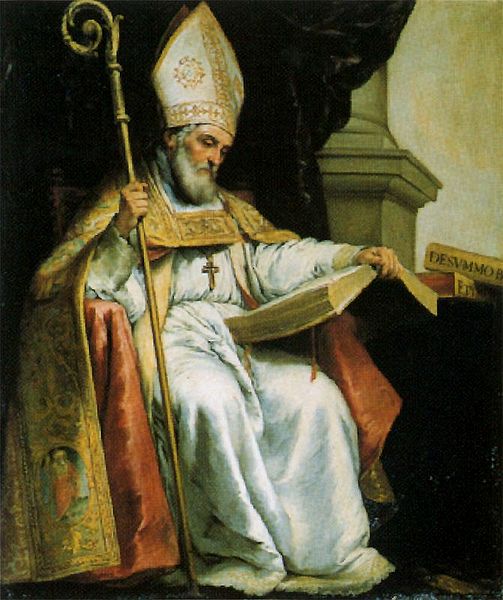
St. Isidore was a Spanish scholar and cleric. He was the archbishop of Seville for three decades. He was considered “the last scholar of ancient times” by some historians. AND…he was the inventor of the period, the comma and the colon.
Isidore lived in the era of Arian Visigoth kings in what is now Spain. It was a time of the disintegration of classic culture, of aristocratic violence and of widespread illiteracy. After years of Vandal, Byzantine and Gothic rule, there was a suppression of classic learning and manners. But there was a light at the end of the tunnel.
Our saint was born in Cartagena, a port city on the Mediterranean, about 560 AD. His parents, Severianus and Theodora, were of high social rank. The family was instrumental in the political-religious maneuvering to get the Arian Visigoths to convert. Isidore’s siblings are also saints: Leander, the archbishop of Seville before Isidore, Fulgentius, the bishop of Astigi, and Florentina, a nun and abbess of several monasteries.
Leander, much older than Isidore, was already a bishop by the time Isidore was old enough to go to school. Leander had started a school, the first of its kind in Spain. This school taught the trivium and quadrivium, classic teaching. Isidore was a good student who mastered classic Latin, despite his brother never being pleased with his work.
Leander lived until 600/601. Isidore succeeded to the archbishopric of Seville.
Bishop Isidore recognized that the spiritual and material welfare of the people depended on a melding of the remnant Roman and the ruling barbarian cultures. He attempted to merge the two cultures into one. He used all available religious resources and succeeded. He practically eradicated the Arian heresy as it was in Spain and stopped the heresy of Acephali at the second council of Seville in 619. He strengthened religious discipline in his see. Meanwhile, Isidore improved education in Seville.
While fighting all this, Isidore was a preeminent scholar. He introduced Aristotle to Iberia before the Arabs introduced him several centuries later. He wrote over a dozen major works. His largest work was Etymologiae, a 20-volume encyclopedia of all knowledge of the ancient world. It contained fragments of works lost to us.
In the religious-political world, Bishop Isidore conducted several councils. The Third Council of Seville, in 624, questioned the concern of Jews being forced to convert. In the Fourth Council of Toledo, all the bishops of Hispania met in 633. One point made was that all bishops were obliged to establish seminaries similar to the school at Seville. It called for a forced removal of children from the crypto-Judaic homes and to be educated as Christians. It also forbad Jews and Christian Jews from holding public office. Isidore claimed that Jewish practices were deliberately disingenuous.
Bishop Isidore died 4 April 636. He was between 75 and 80. He was buried in Seville. When the Arabs took over Hispania, they honored him. His remains were transferred to the new Basilica of San Isidoro in Leon. Later, some relics were moved to the cathedral of Murica.
The Church also honored him. Pope Clement VIII canonized him in 1598. Pope Innocent XIII named him a Doctor of the Church in 1722. April 4 is his feast day.

Recent Comments